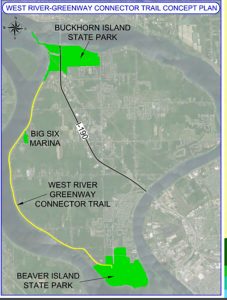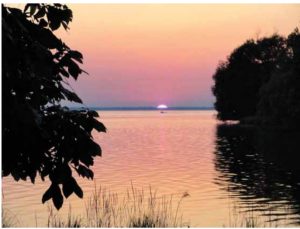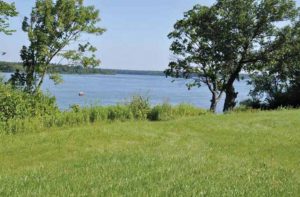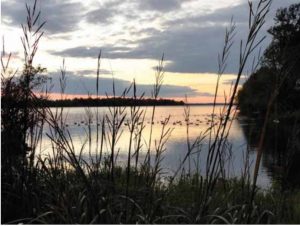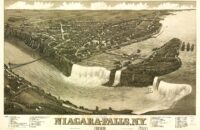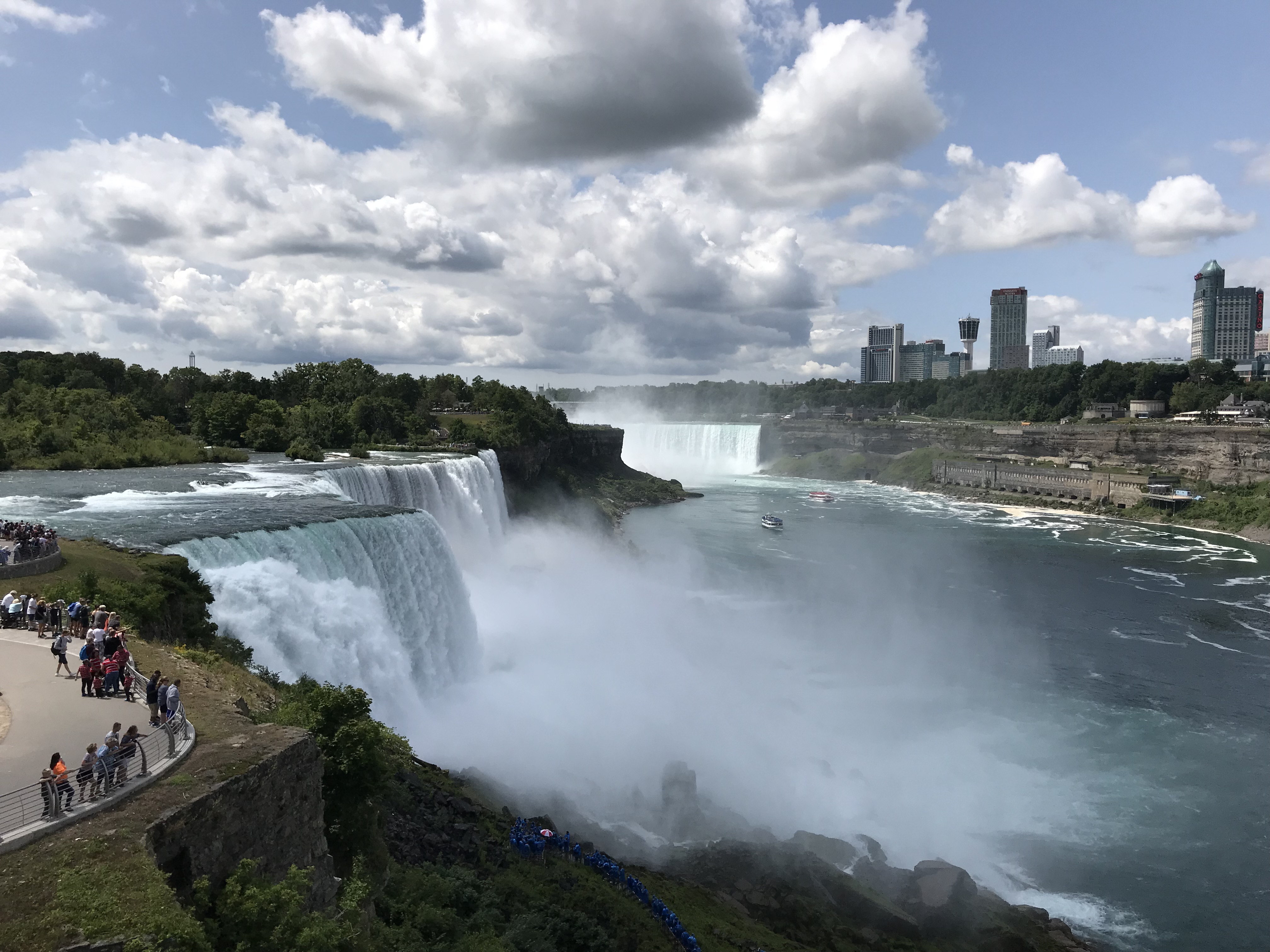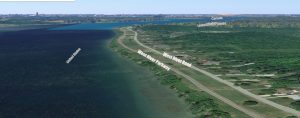
It might be fair to say that with the simple expedient of closing down West River Parkway to motorists and making it accessible to bikers and hikers, the region will add a jewel to its waterfront parks system. A world class nature park will open up before our very eyes, drawing people seeking “pensive contemplation”, as Fredrick Law Olmsted called it, to enjoy the heretofore almost unexplored and glorious West Branch of the Niagara River – as viewed from one of the world’s great fresh water islands, marvelous Grand Island, New York.
If all goes according to schedule, opponents of the West River Greenway Connector Trail, the $2.5 million state and federally-funded initiative to close the West River Parkway and convert it into a bike trail, will meet tonight at 7 p.m at Grand Island High School, 1100 Ransom Road, in the main auditorium.
As we reported last week, a backlash from some West River Road residents against the project, which was originally approved by various government agencies going back to 2013 and has been the subject of public meetings and information sessions over the past two years, is taking shape.
We published photos of examples of what appear to be the appropriation of state waterfront property by private homeowners up and down West River Parkway, which runs parallel to West River Road along the entire eight miles of Grand Island shoreline from Buckhorn Island State Park at the northern tip of the island, to Beaver Island State Park at the southern end.
It seems that, as our published pictures revealed, over the decades, certain West River Road residents, some of whom are behaving in a manner not unlike what might be called your classic NIMBY’s, have come to consider the public shoreline their own, cutting down trees and shrubbery on the state-owned property to enhance their view of the Niagara River, routinely mowing what once served as habitat for migratory birds, and constructing all manner of docks and decks (some makeshift, some quite elaborate), picnic spots, patios and campfire rings, some even having the audacity to post “private property” signs on their squatters’ riverfront leisure spots.
The West River Greenway Connector Trail, which many West River Road residents object to, has rather ambitious objectives. As listed in a State Parks meeting guide from July, 2016, these include “creating an alternative transportation connection between the cities of Buffalo and Niagara Falls that will be safer for non-motorized vehicles, provide a critical missing link in the Niagara River Greenway Trail system, enhance connectivity and improve pedestrian & bicycle safety, improve air quality and promote health through physical activity.”
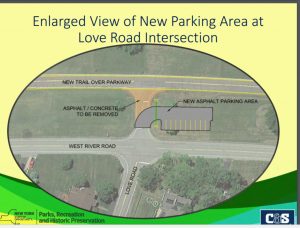
Some parking areas will be added, which means off-islanders will come to the island. Some will spend money here, too.
While it’s doubtful that converting a little-used parkway along an eight-mile stretch of the West Branch of the Niagara River will singularly achieve the host of objectives listed above, it certainly will accomplish some, and will enhance connectivity between Grand Island’s two spectacular state parks.
It will also do something else: Western New York is seemingly plagued by obstructive waterfront traffic infrastructure – from the Robert Moses Parkway in Niagara Falls, to the Skyway in Buffalo and the four-lane 190 that cuts off access to the Niagara River. The Grand Island Connector Trail marks considerable progress in the direction of restoring public use of waterfront for improvement of recreational, environmental and economic opportunities.
The New York State Office of Parks, Recreation and Historic Preservation evaluated and exposed to public scoping three alternatives for the Connector Trail. Two of them proposed that a new, third strip of concrete be paved between the existing West River Parkway and West River Road, both of which would remain open to vehicular traffic. The third, “preferred” alternative that was ultimately accepted closes the underutilized, obsolesced and decaying Parkway and converts it into bike lanes.
At last word, neither a representative from State Parks nor Grand Island supervisor Nate McMurray, who both support the third alternative, along with Congressman Brian Higgins, Buffalo Niagara Riverkeeper and the Niagara River Greenway Commission, will be attending tonight’s meeting.
A new “option 4”, recently conjured up by Grand Island town councilman Mike Madigan, will be presented for consideration.
Grand Island’s Parks and Recreation Advisory Board recently released a “To Whom it May Concern” letter disavowing Madigan’s option 4, characterizing it as “a sidewalk along the West River Service Road (that) adds little recreational value and denies the public any opportunity to view the scenic qualities of the Niagara River.”
Madigan’s sudden crusade to set aside the time, money and effort that has gone into the Connector Trail so far, and return $2.5 million to the funding agencies, by pushing a fourth alternative at the eleventh hour and fifty-ninth minute of a planning process that has been taking place over the last three years, is inexplicable to say the least, especially given that his own political allies voted in favor of the Option 3 initiative at a July 15, 2013 town board meeting.
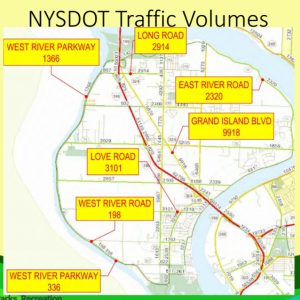
The number of cars per day that travel various roads in Grand Island. One should note that if West River Parkway is closed, West River Road, which is closer to the homes, will see an increase in traffic. Further complicating the issue is that motorists often speed on West River Parkway, which, if speed limits are not carefully enforced, could present a dangerous situation. However, with daily traffic at around 500-600 for both roads, for most of West River Parkway and West River Road, it does not represent, by any means, a much traveled road. Only one section of West River Parkway on the northern portion can it be said to be more highly trafficked, and this may present a quality of life change for those residents who live on that stretch of West River Road.
The resolution that then-supervisor Mary Cooke and four other town board members, including Raymond Billica and Christopher Aronica, passed unanimously, said, in part, “WHEREAS, the Town of Grand Island has developed, in collaboration with the New York State Office of Parks, Recreation and Historic Preservation, a Concept for the West River Connector Trail Project that contains recommendations for the most effective use of the property that will maximize recreational and environmental values; and WHEREAS, the West River Connector Trail Project represents a unique opportunity for the Town of Grand Island that will emphasize the conservation, recreation and environmental values in a way that will define the Niagara River and at the same time add substantial asset value to the Niagara River Greenway;”
In league with Madigan, Billica and Aronica are now opposed to the Connector Trail proposition, voting at the Sept. 19 town board meeting to host what amounts to an ad hoc rally at the high school tonight.
There is no indication that the lead agency on the Connector Trail project, State Parks, has the slightest intention to start from “square one” and conduct an entirely new public scoping process from scratch, and that includes the pie-in-the-sky option 4, or an option 5 that is also being put forth by Madigan, which is “No Path/Trail”.
“Option 4 is expensive, and not really an option,” states Grand Island Supervisor Nate McMurray in a recent public letter, “‘(O)ption 4’ is just a one page suggestion pulled out of thin air. There has been no legal analysis. There has been no engineering analysis. And there is no budget. As far as I know, no one from our town has ever actually talked to anyone from the state about option 4 before it was so abruptly unveiled.”
“My understanding is that the State is looking it over to be considerate,” he continues, “But even a quick analysis indicates that option 4 would cost more and be unworkable. It’s already costing all of us additional taxpayer money to examine. But to actually build it would cost hundreds of thousands of dollars more (conservatively) than the state’s preferred Option 3 (closing the Parkway). It would also require the removal of many ancient trees and considerable excavation for drainage. Plus, no matter what anyone tells you to win your support, it will require guard rails. You can’t put a path between two roads (a danger zone), where a car could slide in at you from either side, without guard rails.”
One blogger from “the Island” put it even more bluntly, “Option 4” DOES NOT EXIST. Drawing two lines on a piece of paper does not make it an option. There have been no engineering and cost estimates performed. None of the background work that is needed for a public works project has been completed. Continuing to promote a make believe option, is just getting people riled up. Now, we are going to hold a public meeting that the State has not agreed to attend. All so the supporters of this make-believe “Option 4″ can march up to the microphone and say they support that option. Again, that option only exists in fantasy land, and its creator’s head. Who created the make-believe option that has everyone on West River up in arms? Councilman Mike Madigan.”
“Please remember, people have been talking about a project for West River for years. But no matter what plan has been put forward, there has been push back. That’s why West River still sits as it is, in limbo, covered in weeds and cracking pavement, without any real, public waterfront access besides some unauthorized bonfire pits and beaches on public property behind the weeds,” added McMurray.

